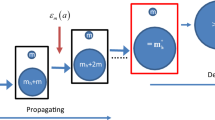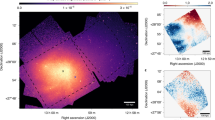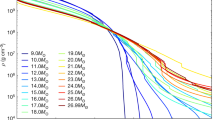Abstract
Recent evidence of a finite rest mass for the neutrino has led to a revival of the idea that these particles may provide the unseen but dynamically indicated matter on cosmological scales of galactic halo and larger size. In the early Universe, the free streaming of collisionless neutrinos is seen to damp out perturbations less than of the order of tens of Mpc long1–5. A numerical simulation of the clustering of collisionless particles in a universe with this type of perturbation spectrum6 has led to the formulation of a cell structure with large voids. Many observations7,8 support the existence of such a structure on scales of tens of Mpc. However, collapse of perturbations of this size leads to velocities of the order of 1,000 km s−1, and as the neutrinos presumably cannot cool, this seems to be too large for their inclusion in galactic haloes, which have much smaller velocity dispersions. Thus it has been suggested that neutrinos cannot cluster in galactic haloes without some means to ‘save’ smaller-scale perturbations3,4,9. Furthermore, if neutrinos of mass ∼30 eV form galactic haloes, the phase space density must be very close to the primordial one10—and phase mixing is often associated with collapse. Although the average value of the velocity dispersion may be reduced if the perturbations are anisotropic11, a disparity still remains. I now present a numerical simulation which shows that if the initial perturbations are sufficiently anisotropic, the collapse of very large perturbations of collisionless particles leads to a condensation of particles with low velocity dispersion and high phase-space density, which may easily fragment.
This is a preview of subscription content, access via your institution
Access options
Subscribe to this journal
Receive 51 print issues and online access
$199.00 per year
only $3.90 per issue
Buy this article
- Purchase on Springer Link
- Instant access to full article PDF
Prices may be subject to local taxes which are calculated during checkout
Similar content being viewed by others
References
Bisnovatyi-Kogan, G. S. & Novikov, I. D. Soviet Astr. 24, 516–517 (1980).
Doroshkievich, A. G., Zel'dovich, Ya. B., Syunyaev, R. A. & Klopov, M. Yu. Soviet astr. Lett. 6, 252–259 (1980).
Bond, J. R., Efstathiou, G. & Silk, J. Phys. Rev. Lett. 45, 1980–1984 (1980).
Klinkhaamer, F. R. & Norman, C. Astrophys. J. Lett. 243, L1–L4 (1981).
Wasserman, I. Astrophys. J. 248, 1–12 (1981).
Doroshkievich, A. G. et al. Mon. Not. R. astr. Soc. 192, 321–337 (1980).
Einasto, J., Joêveer, M. & Saar, E. Mon. Not. R. astr. Soc. 193, 353–375 (1980).
Kirshner, R.P., Oemler, A. Jr, Schechter, P. L. & Schechtman, S. A. Astrophys. J. Lett. 248, L57–L60 (1981).
Davis, M., Lecar, M., Pryor, C. & Witten, E. Astrophys. J. 250, 423–431 (1981).
Tremaine, S. & Gunn, J. L. Phys. Rev. Lett. 42, 407–410 (1979).
Barrow, J. & Silk, J. Astrophys J. 250, 432–439 (1981).
Hockney, R. W. & Eastwood, H. W. Computer Simulation Using Particles (McGraw Hill, New York, 1981).
Zel'dovich, Ya. B., Klypin, A. A., Khlopov, M. Yu., & Checketkin, V. M. Sov. J. nucl. Phys. 31, 664–669 (1980).
Melott, A. Phys. Rev. Lett. (in the press).
Author information
Authors and Affiliations
Rights and permissions
About this article
Cite this article
Melott, A. The formation of galactic haloes in the neutrino-adiabatic theory. Nature 296, 721–723 (1982). https://doi.org/10.1038/296721a0
Received:
Accepted:
Issue Date:
DOI: https://doi.org/10.1038/296721a0
This article is cited by
-
How galaxies acquire their neutrino haloes
Nature (1983)
Comments
By submitting a comment you agree to abide by our Terms and Community Guidelines. If you find something abusive or that does not comply with our terms or guidelines please flag it as inappropriate.



